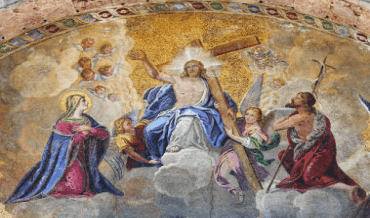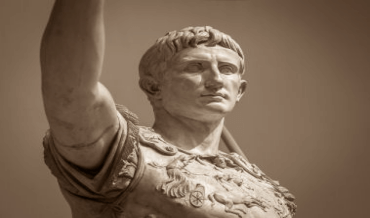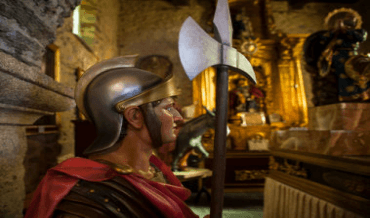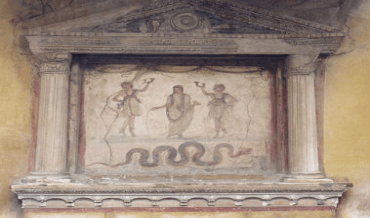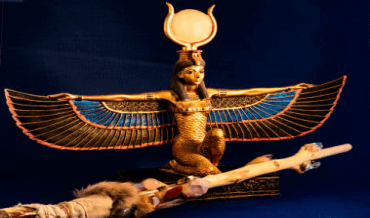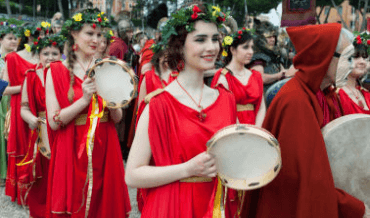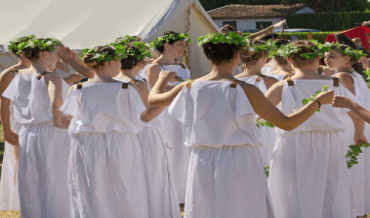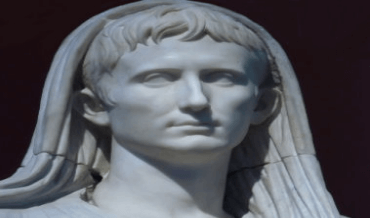The Beginnings of Religion in Ancient Rome

The origins of the Roman pantheon (Related Page: The Pantheon in Rome) began with the small farming community that made up the ancient village of Rome.
The foundations of the mythology included nameless and faceless deities that lended support to the community while inhabiting all objects and living things.
Numen, as the belief in a pantheistic inhabitation of all things is called, would later take root in more clearly defined system of gods, but early on this belief that everything was inhabited by numina was the prevalent system.
According to some sources the religion of the very earliest Romans was simple animism: beliefs were centered around spirits which were not personified. Modern sources however have rejected this theory, stating instead that belief in the Roman gods was present in the very earliest religion.
Even though the early Romans were not very concerned with the distinct personalities of each god within their pantheon, there was a rigid clarification of what each particular deity was responsible for.
All aspects of life within Rome were guided not only by the pantheon of familiar names we are accustomed to, but to the household cult of the Dii Familiaris as well.
With this belief set, every family or household was believed to be assigned a guardian spirit known as the Lar Familiaris (Lars). All family functions included these spiritual guardians in some form or another. Among these spirits that played a role in the spiritual life of Romans were Genii for men and junii for women.
Each of these individual deities stayed with a person for life and represented the creative force that determined gender and allowed individuals to grow, learn and behave morally within society.
The Dii Familiaris were so ingrained within the household that several spirits were assigned to specific responsibilities within a home. Forculus protected the door, Limentinus the threshold, Cardea the hinges, and Vesta the hearth.
Roman Gods and Goddesses
Most of the Roman gods and goddesses were a blend of several religious influences. Many of these were introduced via the Greek colonies of southern Italy and others had their roots in the Etruscan or Latin tribes of the region.
In some cases the Etruscan or Latin names survived throughout the cultural existence of Rome, but many were adopted so completely that they maintained their names from other cultures.
In the east, the Greek names remained the choice of the people and the major gods of the system therefore, were known by both.
Rites of the early religion were simple and exact. As Rome grew, the beliefs of those who were conquered were slowly integrated into Roman culture and religion. Many Greek gods and rituals became a part of Roman religion, and through study of Greek art, literature and mythology, many Greek gods came to be identified with Roman gods.
The early Romans had no religious temples or statues to honor the spirits or gods. The first temples and statues of gods in Rome were built by Etruscan kings. The first of these, a temple on Capitaline hill, was built to honor Jupiter, Juno, and Minerva.
The gods of the Roman pantheon began taking on the forms known today during the dynasty of the Etruscan kings in the 6th century BC. These gods, Jupiter (Zeus), Juno (Hera), and Minerva (Athena), were worshiped at the grand temple on the Capitoline Hill.
As Rome's power grew and expanded throughout the known world, the Roman Empire came into contact with the cultures and religious beliefs of many cultures.
The Romans, happy to absorb and assimilate any culture they encountered thereby reaping the benefits of both its wealth and religious influence, were a mosaic of belief systems.
Contract with the Gods
On the most basic level, the ancient Romans saw their religion as a contract between man and the gods.
For this reason, ceremonies were performed with the greatest attention to detail; if mistakes were made, it was believed that the gods would no longer be compelled to uphold their end of the contract.
Along with the idea of a contract with the gods came the practice of the votum. The votum was a specific vow to the gods. If one wanted a specific favor or blessing, he would promise to complete certain rituals or sacrifices if his prayers were answered.
The Integration of Foreign Gods
Foreign gods and customs not only played major roles but were also given temples and priesthoods within Rome itself.
The goddess Cybele, a Phoenician god was adopted during the Second Punic War to counteract any benefit that Hannibal may have gained. Even after his defeat, Cybele remained an integral part of the Roman system.
Another very popular foreign god was the Persian god Mithra. Overwhelmingly supported in the legions, this deity offered eternal salvation for the immortal soul, and its popularity helped pave the way for the later Christian cult whose similarities made its adoption less difficult.
Religion Within the Family
Within the family, the pater familias, of head of the household acted as the priest of the household. He oversaw all religious activities within the home with the help of his wife.
One of the most important aspects of the family religion was the family cult. Romans believed that offerings to their deceased ancestors were crucial to their happiness in the afterlife.
Furthermore, they feared that if they neglected their duties to their ancestors, the unhappy ancestral spirits would haunt them and their families. Because of this, Romans felt that it was vital to see that their ancestors were well cared for during their lifetimes and in future generations.
Carrying on the family name, then, was a major concern of the pater familias.
In order to ensure preservation of the family, marriage was viewed as a solemn religious duty. Before the wedding, the auspices were consulted to ensure the approval of the gods and a favorable marriage. The new wife was completely separated from her family and taken into her husband's family.
Proper worship of the household gods and spirits was unquestionably just as important as the ancestral cult. Prayers and offerings were usually performed in the space of time between dinner and desert, though some especially pious families chose to perform this duty in the mornings as well. These duties were performed every day, and all family occasions were accompanied by ceremonies.
Each gens (clan) had its own sacra, or rites, which were considered to be a necessity not only for the family itself, but also for the state.
Roman Priestly Colleges
Within Rome there existed several orders, of colleges, of priests. Some of them were devoted to one or more gods, such the Salii, who worshipped Mars and the Salii Colini who devoted themselves to Quirinus (the deified Romulus).
Several oversaw various public events or works. The pontifices arranged the calendar, and the augures performed the duty of interpreting the will of the gods through reading the auspices. The auspices were taken before any public occasion or action to ensure that the gods were pleased.
One priestly college that was very important to Rome was the Commission of Fifteen. They were in charge of the Sibylline books which were said to foretell the history of Rome.
Perhaps the best known priestly college was the College of Vesta, or the Virgines Vestales. The Vestal Virgins were charged with the duty of caring for the sacred fire at the Aedes Vestal (Temple of Vesta). Vestals were selected from girls between the ages of six and ten years old, from families in which both parents were still living. They served for thirty years, spending ten years learning, ten years performing their duties and ten years training new vestals.
The Emperors as Gods
With the passing of the Roman Republic into that of an Imperial system, the nature of Roman religion expanded again to include the Emperors themselves.
Julius Caesar, having claimed to be a direct descendent of Aeneas, the son of Venus, was among the first to deify himself in such a manner. At first, such a system of human divinity was largely rejected by the masses, but the popularity of Caesar helped pave the way for future leaders.
As the Imperial system gained hold, it was common practice for the Emperors to accept divine honors before their deaths. These living gods, in some cases, required sacrificial rituals as signs of loyalty and ingrained themselves with the older more traditional pagan gods.
The requirement of a sacrifice to the emperor, as well as the forced belief in the complete pantheon became a significant source of conflict with early Christians. As Christians refused to worship the emperor as a god, persecution of the Christians and conflict with the cult was a constant source of strife.
The Evolution of Roman Religion
After the origination of Roman religion from various sources and peoples, its importance waned as the study of Greek philosophy waned during the late republic.
The importance of religion was renewed, however, by Caesar Augustus. Roman religion grew as it blended with some Eastern and Oriental religions, and cults such as the Cult of Magna Mater gained followers. The Cult of Isis and the Cult of Mithras developed from Eastern religions.
During the Imperial Age, the Cult of the Emperor developed. The practice of deification allowed Emperors to be worshipped as gods, and the Cult of the Emperor started to take the place of the old state religion in the provinces, although in Rome itself it was not permitted to worship an emperor while he still lived.
Rome was home to many followers of Judaism, and the religion made progress in some parts of the Empire. Christianity later came from the East, and became popular with Orientals and the lower classes. As Christianity spread, the older religions slowly diminished.
The Rise of Christianity in the Roman Empire
Emperor worship would continue until late in the western Empire until the reign of Constantine. In the early 4th century AD, Constantine either converted to Christianity or made it an acceptable part of Roman religion, eliminating the emperor deification altogether.
Later Emperors such as Julian attempted to revive the old ways, but the deeply rooted Mithraism, and Christian cults combined were firmly set within Roman society.
By 392 AD, Emperor Theodosius I banned the practice of pagan religions in Rome altogether and Christianity was, without question, now the official religion of the state.
Discover More About Religion in Ancient Rome
Visit the sections below to find out more information regarding religion in Ancient Rome.


